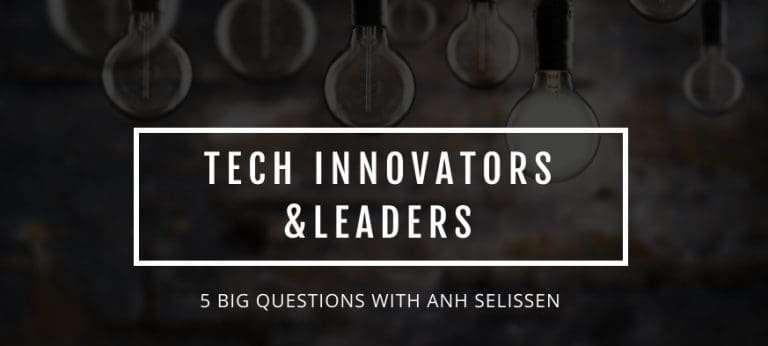Tech Leaders & Innovators: 5 Big Questions with Anh Selissen

 Welcome to our new Tech Leaders & Innovators Series, which is designed to help IT professionals stay on top of their game and drive business growth. We envision this as a series of conversations with exceptional IT execs who can share unique perspective, experience and expertise on IT practice in general as well as their specific sectors.
Welcome to our new Tech Leaders & Innovators Series, which is designed to help IT professionals stay on top of their game and drive business growth. We envision this as a series of conversations with exceptional IT execs who can share unique perspective, experience and expertise on IT practice in general as well as their specific sectors.
First up is a conversation between Dominica Council, Director of Public Sector Services at Bridgepoint Consulting, and Anh Selissen, the new CIO at The Texas Department of Transportation. Most recently, Anh served as Deputy Director of Information Technology at the Texas Comptroller of Public Accounts, the state’s chief tax collector, accountant, revenue estimator and treasurer.
Dominica and Anh used our 5 Big Questions as a jumping-off point for a strong discussion of the practicalities of IT innovation in the public sector, and the key to making positive strides in any IT leadership role. Read on to find out what Anh had to say.
Q: HOW DO YOU STAY AHEAD OF THE CURVE AS AN ORGANIZATION?
A: For me, it’s not so much about getting the next hot technology. At the end of the day, if we do not meet the business needs of the organization, any “cool” solutions you bring in will be for naught. Plus, you’ll create unnecessary tension between IT and the business, because naturally your customers are going to be frustrated.
I recommend first getting on the same team with the business. Understand each department’s strategies for the next 5-10 years, then work together to identify the right technologies to successfully achieve their goals. This could mean embracing Platform-as-a-Service (PaaS) and empowering the business to develop some of their own solutions. Or it could mean taking a bi-modal approach to IT delivery — one mode to support legacy systems; while another more flexible mode pushes new features and functionality to the business faster.
Finally, I rely on really good vendor partners for guidance and leadership about emerging technologies. When you’re in the trenches of state government, you don’t necessarily have the bandwidth or expertise to implement the latest solutions emerging in the private sector. I look to critical partners for recommendations on all kinds of things, like solutions to improve overall manageability or those that can enable my team to roll out enhancements more quickly.
Q: CAN YOU SHARE ANY EXAMPLES OF WAYS YOU’VE ADAPTED OR EVOLVED YOUR ORGANIZATION TO MEET CHANGING NEEDS?
A: When I first arrived at the Texas State Comptroller’s office, the tax system was more than 20 years old. Any changes to the system caused instability. Plus, the business didn’t trust IT and IT wasn’t very collaborative with the business.
Modernizing and stabilizing the tax system is a big challenge and it’s very high profile, as you might imagine. We decided to implement an Agile methodology, which gave us the flexibility to modernize incrementally and improve overall stability and manageability. We trained all of the IT staff in Agile, as well as those in the business who worked closely with IT. Then we created various product teams to produce enhancements in smaller chunks.
None of this would work without rebuilding trust and communications with the business. A solid communication plan was absolutely critical to our success. We engaged early with the business to build relationships, understand their pain points, and prioritize our efforts. We explained the benefits of Agile methodology to business leaders — why and how it would make our modernization work more digestible for their staff, more manageable for IT, and ultimately more successful. Being agile would also allow IT to deliver small improvements quickly, so the business could see progress and benefits ASAP. Our communication efforts didn’t just focus on the leadership. We made sure to communicate with all levels of the organization.
Support and training were also important. At the end of the day, the people that make change successful are the SMEs (subject matter experts). You have to bring the entire IT organization forward, because it’s not fair to bring in lots of new tech but leave your team behind. At some point, your vendor partners will finish their work and leave. You don’t want your people to be lost and unprepared to use their new tools and processes.
Q: WHAT’S THE BIGGEST CHALLENGE YOU’VE FACED WHEN TRYING TO IMPLEMENT NEW TECHNOLOGIES OR INNOVATE IN SOME WAY?
A: I think the biggest challenge is overcoming resistance to change. When people have been doing their jobs a certain way for a number of years, they really understand the technology and their workflow. It’s scary when new tech is introduced. People can feel like the burden of success falls solely on them.
In IT, many of our people are solely focused on their areas of expertise. Implementing new technologies can involve risk and knowledge transfer, and IT folks fundamentally don’t like risk. There’s an emotional learning curve as much as there is a new skill set to acquire. On the business side, there’s a learning curve, too. During the ramp-up period, people get frustrated because things don’t happen quite as fast as they want.
Ultimately, we all have to accept that change is constant, and it’s part of everyone’s job to make sure this specific change is successful. That means making sure IT staff have time to learn so they can successfully implement the new technology. And it means that the business needs to allow time, space and flexibility for the new technology to roll out and start making things better.
Q: WHAT NEW TECHNOLOGIES/TOOLS/TRENDS ARE YOU EXCITED ABOUT OR EYEING FOR FUTURE INITIATIVES?
A: First and foremost, I’m focusing on Platform as a Service (PaaS). In the past, IT did everything — development, administration, etc. It’s important for IT to recognize that the trend is moving outward. PaaS allows IT to maintain control over certain platforms and components while enabling the business to develop its own little applets to meet specific needs. We’re seeing that these applets can be spun up and function well without needing IT so heavily. That’s a good thing for everybody.
Second, I’m excited about the growth of cloud adoption in the public sector. I don’t think we’re going to host on-premise solutions for much longer. Today’s cloud solutions offer both agility and robust security. That means the business can implement the tech that they need quickly and easily, and IT can get the security safeguards, support and monitoring capabilities they need to protect their environment.
Finally, I’m looking at ways to implement cybersecurity without undue impact on day-to-day operations. People security is important but sometimes it’s a burden on their daily work because some technologies can slow down email delivery, network performance, etc. Security measures can slow down IT, too — such as when you implement a new cloud solution and the information security requirements take a long time. We need to strike a balance between keeping our organizations safe and helping the business move forward effectively.
Q: FINALLY, WHAT’S YOUR ONE PIECE OF ADVICE TO OTHER LEADERS?
A: Good leaders step outside of the technology world and seek to understand the business and IT’s internal customers. A lot of IT leaders tend to stay so siloed in the tech world that they forget the “people side” of their job. It’s important to balance the tech bells and whistles with the ability to build relationships with the people you’re serving. I’m a very good technologist but I’m a great people person. That has been the real key to my success.
Oh, and one more thing: Be passionate about the role you’ve been given. If you are being given an opportunity, embrace it and go do a kick-ass job!
BRINGING IT ALL TOGETHER
Dominica and Bridgepoint’s Public Sector Technology Consulting team understands the challenges of leveraging technology in state and local government. Resources are often limited, but constituent and resident demands are high. There’s increasing pressure for more transparency in governmental processes and expenditures. Plus, the challenge of enabling digital transformation is coming — for most, it’s coming sooner rather than later. Bridgepoint Consulting can help with compliance and modernization assessments, third-party validation/verification/oversight, strategic recommendations and roadmaps for digital transformation, and more.
Learn more about our Public Sector services here.




